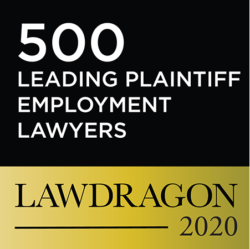The American Chiropractic Association reports that 80 percent of Americas will suffer from a painful musculoskeletal condition during their lifetimes. In fact, half of all working Americans are currently suffering from bone, joint, muscle, and spinal pain. Back pain is also the most common disabling condition worldwide, and there’s a good chance that you’re experiencing back discomfort as you read this.
At DarrasLaw, potential clients commonly ask us whether they can claim individual or group long-term disability benefits for chronic back and neck pain. The answer is, “It depends.”
You might qualify for individual or group long-term disability benefits if a car accident or fall caused your injury. You may also face a wrongful delay, denial, or termination of individual or group long-term disability benefits if you suffer from “age-related” non-disabling degenerative conditions.
Many individual and group long-term disability insurers issue blanket wrongful denials of long-term disability benefits for common musculoskeletal conditions like back and neck pain. Many individual and group long-term disability insurers severely limit claimants from receiving benefits for certain musculoskeletal problems because they are “age-related” or due to a limited policy benefit period. However, not every musculoskeletal condition is age-related. Any number of injuries or illnesses can cause a disabling musculoskeletal condition and entitle you to individual or group long-term disability benefits.
At DarrasLaw, our award-winning long-term disability attorneys and top-rated ERISA group lawyers have more than 100 years of cumulative litigation and claim experience in the field of long-term disability law. Our stellar individual disability lawyers and skilled national ERISA group attorneys know the insurance companies’ tricks, especially when it comes to their wrongful delays, denials, and terminations of benefits for muscle and joint pain.
If you’re one of the millions of Americans suffering from a disabling musculoskeletal condition, you may qualify for individual or group long-term disability benefits. To schedule your completely free disability policy analysis and free claim consultation, call DarrasLaw today at 800-898-7299 or contact us online.
Understanding the Musculoskeletal System
Your musculoskeletal system consists of:
- Bones
- Muscles
- Tendons
- Ligaments
- Cartilage
- Joints
- Connective tissue
This is the largest system in your body, and it allows you to support your weight and move. Your musculoskeletal system is generally the first to wear down with age due to constant use. Arthritis, one of the most common musculoskeletal conditions, occurs when the cartilage between your bones wears down. This causes your joints to grind together. This system is also your body’s first line of defense. Your skin, muscles, and bones protect your lungs, bone marrow/blood supply, heart, and brain from infections, burns, viruses, and trauma. It’s easy to understand why musculoskeletal injuries and illnesses are so common.
Your bones also store certain essential nutrients, make your blood, and regulate fat storage. Disabling diseases that damage your bones can also interrupt these essential functions, causing illnesses. Whether you can claim individual or group long-term disability benefits for a musculoskeletal condition often depends on the medical evidence and proof you submit to support your valid disability claim.
Common Skeletal Disabilities
The first part of your musculoskeletal system is your skeleton itself. This means your bones, which are often plagued by:
- Fractures (broken bones) – Whether it’s a broken toe or femur, fractures hurt. Even minor fractures, such as a hairline wrist fracture to a professional baseball player, can be disabling. Serious fractures, such as clean breaks and crushing injuries, can result in something called compartment syndrome. The pressure from internal bleeding causes this extremely painful condition. This deprives your muscles and nerves of their blood supply in the injured area. It further exacerbates a fracture and often necessitates emergency surgery.
- Bone spurs – These small growths form on your bones. They’re typically not dangerous but can disable you if they begin to rub against other bones, ligaments, and nerves. Bone spurs in your joints and spine can cause extreme pain, difficulty moving, swelling, numbness, tingling, and weakness.
- Avascular necrosis – This rare condition occurs when your bones begin to die due to lack of blood supply. Your bones will become weak and will collapse if deprived of blood. This may happen in less than a few months. Avascular necrosis may lead to amputation, chronic pain, and an inability to move the damaged areas of your body.
- Hip and knee replacements – Did you know that each year more than one-million Americans undergo a hip or knee replacement? This is typically due to degeneration, a broken hip, or an injury or illness. It can take you time to recover from knee or hip surgery, especially because these areas of your body bear the most weight. Your individual or group long-term disability insurance company may require proof that you suffer from a joint deformity or limitation before you qualify for long-term disability benefits.
- Bone cancer – Osteosarcoma is a serious cancer that forms in the bone. Treatment typically involves radiation and removal of the tumor. Leukemia is a blood cancer that develops in the bone marrow. Any cancer can spread to the bones if it metastasizes.
- Osteoarthritis – This is the most common skeletal condition. It leads to pain in your joints, especially in the knees, hips, hands, and elbows. If your condition progresses and you need joint replacement surgery, you may qualify for individual or group long-term disability benefits.
- Scoliosis – This condition typically develops during your teenage years and is characterized by the abnormal curvature of your spine. Some claimants are born with scoliosis and others can develop the condition after a traumatic injury or as the result of osteoporosis. Scoliosis can limit your ability to move, sit, stand, and sleep. Many patients need a rod inserted into their spine to hold them upright or they must wear a full torso brace. Moving and working with scoliosis can prove extremely difficult.
- Osteoporosis – This condition typically develops in women older than 50. It causes your bones to become weak and brittle because your body is losing too much bone mass or it’s not creating healthy bones. This condition leaves the bones porous and susceptible to fractures. Some patients with severe osteoporosis can even suffer fractures from sneezing or tripping.
- Spinal stenosis: Stenosis of the spine involves a narrowing of your spinal canal, which can occur with time or manifest as a genetic condition. It can endanger your spinal canal if it narrows to the point where it begins compressing your central nervous system, which sends signals from the brain to the rest of your body. This can actually lead to paralysis, another serious condition for which you may claim individual or group long-term disability benefits.
- Bunion surgery: This often corrects a genetic condition where your big toe begins to crush into your smaller ones, causing a painful bone bulge in your foot. This makes walking extremely painful and requires surgical correction. The difficult and painful surgery often involves breaking the bones and joints of your foot to reset the toe.
Skeletal injuries and illness often result in disabilities. To qualify for individual or group long-term disability, it’s not enough that you suffer from a musculoskeletal condition. These disabilities must prevent you from performing the important duties of your occupation with reasonable continuity and in the usual and customary way.
Common Muscular and Connective Tissue Disabilities
Your muscles and tendons hold your body together and give it the ability to move. While your bones provide your body with structure, your muscles and tendons make you mobile. Degenerative and connective tissue diseases, therefore, can prove particularly disabling. These conditions include:
- ALS (Lou Gehrig’s disease) – This is an incurable, degenerative muscle condition. It attacks your nerves so they can’t carry messages from the brain to your muscles. This devastating disease causes your muscles to slowly atrophy. Most patients only live about five years after their initial ALS diagnosis. If you have this serious condition, take advantage of your individual or group long-term disability benefits to protect your family.
- Lyme disease – This is actually a bacterial infection transmitted through a tick bite. It can cause paralysis and muscle and joint pain as the infection spreads to the joints. Even months after a tick bite you can develop neck stiffness, severe arthritis and joint swelling, pain in your tendons and bones, cognitive problems, and spinal cord inflammation.
- Rheumatoid arthritis – This autoimmune disorder occurs when your immune system begins to attack the tissues surrounding your joints. Rheumatoid arthritis typically starts in smaller joints, such as your fingers and toes. It manifests with pain, swelling, and stiffness, especially in the morning. As your body attacks your connective tissues, they will begin to thicken, making movement more difficult. Patients with rheumatoid arthritis may need hip or knee replacements.
- Paralysis – Your brain sends signals to the rest of your body through your spinal cord, which has nerves that transmit the brain’s signals to your muscles. Through these nerves, your brain will tell you when and how to move. Damaged or severed nerves won’t regenerate. This means all signals to your body below the area of damage will cease. You’ll likely lose feeling below the site of the injury. This can also lead to muscle atrophy and other conditions. Paralysis from a spinal cord injury is not curable, and patients often qualify for individual or group long-term disability benefits.
- Reflex sympathetic dystrophy (RSD) or complex regional pain syndrome – Anything from breast cancer to a car accident can trigger reflex sympathetic dystrophy. This commonly occurs after an injury to your arm or leg when the nerve becomes inflamed. This causes your muscles to contract, resulting in pain and swelling. If you suffer from extreme muscular pain, you may claim individual or group long-term disability for complex regional pain syndrome.
- Torn ligaments and tendons – Athletes and active individuals may experience painful ACL, MCL, or PCL injuries. A torn ACL is an example of a ligament injury. This occurs when the main ligament supporting your knee is almost completely torn, resulting in debilitating pain and an inability to walk. ACL tears typically require surgical treatments.
- Whiplash – This common tendon injury often occurs after a car accident, when your head is thrown forward and snaps back rapidly. Extreme whiplash can cause months of pain and leave you unable to lift, hold a static posture, or use a computer.
- Piriformis syndrome – This neuromuscular disorder occurs when the muscles in your back compress and pinch the sciatic nerve in your lower back. The piriformis muscle is essential to movement, as it supports your hip joint, which allows you to walk. Activity that requires hip and leg movement also involves the piriformis muscle. This painful syndrome can occur in combination with a piriformis injury and may qualify you for individual or group long-term disability benefits.
Any number of diseases and injuries can attack the muscles, bones, joints, tendons, and connective tissues that form your vast musculoskeletal system. Be aware of your musculoskeletal symptoms even with seemingly unrelated diseases, such as cancer or HIV.
Musculoskeletal pain can leave you unable to sleep, drive, shower, cook, type, walk, or work on a computer. If your muscle, tendon, or bone injury leaves you unable to perform the material and substantial duties of your occupation, you may qualify for individual or group long-term disability benefits.
Contact America’s Top-Rated Long-Term Individual Disability Attorneys and Nationally Experienced Group ERISA Lawyers at DarrasLaw
Led by America’s top long-term disability lawyer, Frank N. Darras, DarrasLaw’s respected individual disability lawyers and prominent group ERISA attorneys know that a serious musculoskeletal disability can disable you from your occupation. We are here to try to help you, no matter where you live.
To schedule your completely free disability policy analysis and free claim consultation, call DarrasLaw’s team of seasoned individual disability attorneys and nationally renowned group ERISA lawyers today at 800-898-7299, or contact us online.













